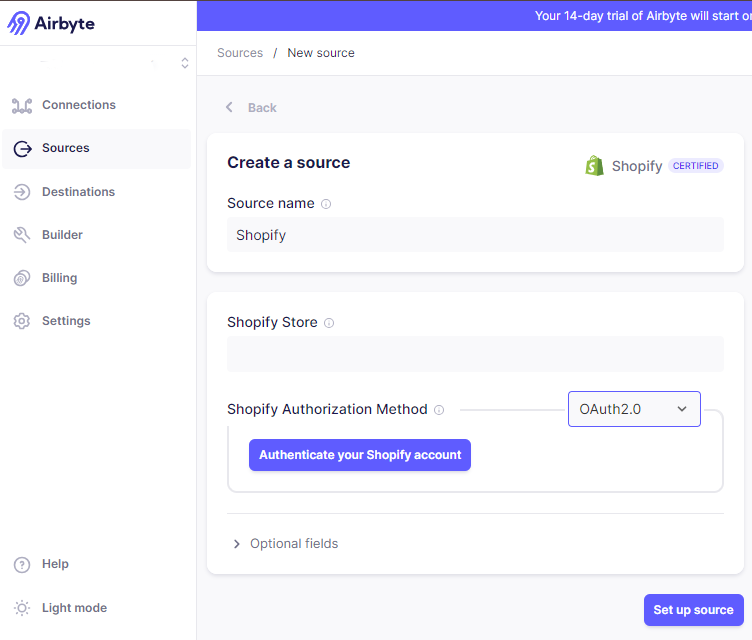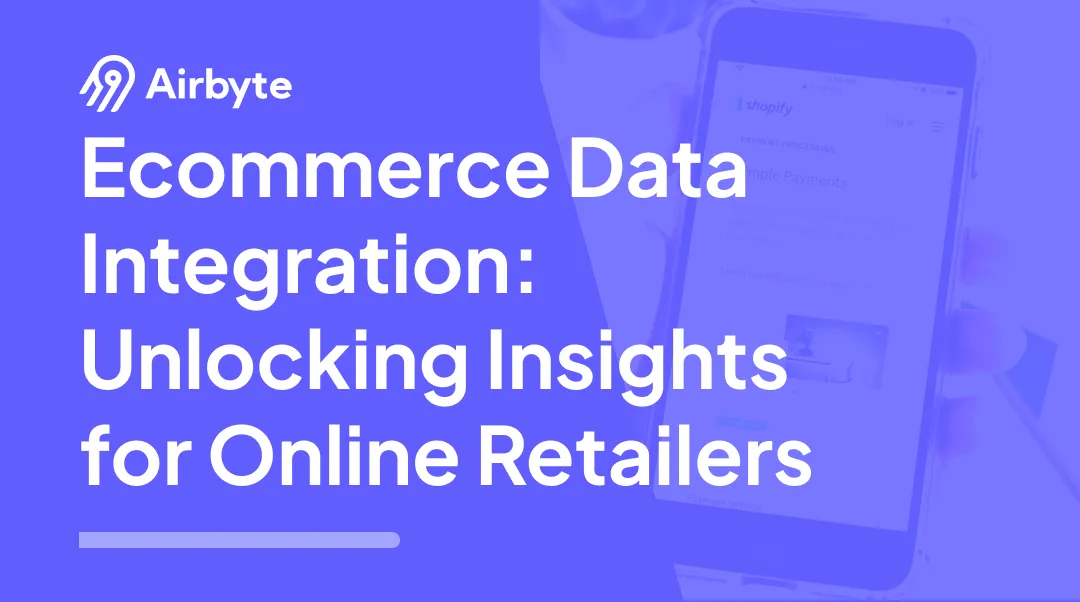E-commerce Data Integration: Unlocking Insights for Online Retailers
Summarize this article with:
✨ AI Generated Summary
Data integration in e-commerce centralizes diverse data sources like sales, inventory, customer interactions, and payments to enhance operational efficiency, personalization, and informed decision-making. Key storage solutions include databases, data warehouses, hybrid systems, and distributed file systems, enabling seamless cross-channel experiences and marketing automation. Tools like Airbyte simplify this process by offering easy, customizable connectors to consolidate data into unified platforms for better analysis and business insights.
Businesses harness substantial data from diverse sources like sales, transactions, or customer feedback in the digital era. Retailers can unearth invaluable insights by seamlessly integrating this data into centralized storage systems like data warehouses.
In this article, you will learn more about the role and importance of data integration in e-commerce applications.
Understanding The Need for E-commerce Data Integration
Before the advent of e-commerce data integration, users faced challenges, such as limited product information, manual order processing, difficulty tracking shipments, and a need for real-time inventory updates. The absence of a centralized platform made it challenging to streamline operations and provide a seamless shopping experience.
However, data integration in e-commerce simplifies processes by connecting various systems and databases. It involves integrating multiple information sources to provide a holistic solution that enhances operational efficiency. These sources may be sales transactions, website analytics, e-tickets, customer interactions, inventory levels, etc. The idea is to unravel these data compartments, giving the complete business picture and empowering you to make data-based decisions. Here’s why:
- Enhanced Customer Experience: By centralizing data, you’ll gain valuable insights into customer behavior, trends, and preferences. As a retailer, you can analyze this information to understand which products are widespread, identify patterns, and tailor your offerings to meet customer expectations.
- Personalization: By interpreting the data, you can customize the shopping experience and offer targeted recommendations, personalized promotions, and more engaging online content by observing customer preferences. This is particularly beneficial for businesses selling print on demand products, as personalized designs and niche-specific items such as custom socks, hoodies, shoes and stickers can significantly boost sales.
- Operational Efficiency: Automated integration reduces manual efforts and minimizes the risk of errors. From inventing the product to order fulfillment, you can use data to streamline operations. This operational efficiency can lead to resource savings by optimizing resource utilization. For example, with custom socks, where every order might have unique specifications, having real-time data can dramatically improve order accuracy and turnaround time.
- Informed Decision-Making: By viewing data in a unified manner, you can make informed decisions, leading to more strategic and effective business operations.
- Competitive Edge: You can gain a compatible advantage if you effectively handle and interpret data. This will allow you to adapt to changes, which helps you to stay ahead of market trends and respond to customer needs, positioning yourself as a leader in the crowded marketplace.
Choosing the Right Storage Options for Your E-commerce Data
Storing e-commerce data is crucial as it is a backbone for streamlined operations and customer-centric strategies. Keeping a detailed description of every customer profile in a repository allows you to understand their behavior and preferences. Here are some common storage solutions for your e-commerce data:
Database Management Systems
Utilizing relational or non-relational databases, such as MySQL, PostgreSQL, MongoDB, or Microsoft SQL Server, ensures structured data storage and facilitates efficient querying. The systems also support complex data relationships, enhancing the versatility and functionality of the database infrastructure.
Data Warehouses
Leveraging data warehousing solutions like Amazon RedShift, Google BigQuery, or Snowflake facilitates centralized storage and analysis for large volumes of structured or semi-structured data. Storing your data in warehouses is helpful as it provides a foundation for collective data analysis and reporting.
Hybrid Approach
A hybrid structure is created by integrating on-premises infrastructure with cloud-based services. This approach offers flexibility, allowing you to leverage the advantages of both on-premises and cloud storage based on specific use cases. You can use a premises server for sensitive data and critical applications while utilizing a public cloud for scale and less sensitive workloads.
Distributed File Systems
Popular distributed systems used in e-commerce include Apache Hadoop distributed file system (HDFC), Amazon Elastic File System (EFS), and Google Cloud Storage. These systems play a crucial role in providing the robust and scalable infrastructure needed to support the dynamic nature of e-commerce operations.
Consolidating Data from Various Sources
Data integration plays a pivotal role in enhancing the functionality and efficiency of E-commerce apps, and its significance is apparent in multiple aspects:
- CRM: Integrating a CRM application with an e-commerce site allows you to collect data on all customer interaction websites and social media channels to send personalized offers automatically. This allows you to access up-to-date customer data and track each customer’s journey through sales channels.
- Inventory & Order Management: Inventory and order management for e-commerce helps businesses enhance operational efficiency, reduce errors, improve customer experiences, and adapt quickly to changing market dynamics. This integration contributes significantly to the overall success of an e-commerce venture. For example, CaratIQ jewelry store system facilitates the inventory management process, sales tracking, and customer relationship management for jewelry stores. By integrating data from sales, inventory, and customer interactions, such software helps businesses streamline operations and improve customer experiences, illustrating the importance of industry-specific solutions.
- Cross-Channel Experience: By connecting data from the web, retail, catalog, and other channels, customers can enjoy a seamless shopping experience. The integration enables consistent product & pricing info across channels, shared shopping carts, in-store pickups of online orders, etc.
- Payment Processing: Integrating payment data from gateways, payment service providers, and banks enables centralized tracking of payments across all orders in one place. This makes reconciliation easier.
- Marketing Automation: Integration with various marketing channels like email, social media, the company website, and advertising platforms allows the creation of unified customer segmentation and buyer personas. This consolidated customer view facilitates executing highly targeted and personalized cross-channel campaigns that help drive more conversions across the business.
- Customer Feedback & Analytics: By leveraging data integration, an E-commerce Consultant can utilize advanced analytics to understand customer behavior, preferences, and feedback across various platforms. This insight is crucial for optimizing product offerings and enhancing the user experience, ultimately driving higher customer satisfaction and loyalty. Furthermore, an E-commerce Consultant can employ predictive analytics to anticipate market trends and customer needs, enabling businesses to stay ahead of the competition and make informed decisions on inventory, pricing, and marketing strategies.
For better analysis, integrating data from these applications into a single consolidated storage can be quite a puzzle. This is where Airbyte comes into the picture.
Airbyte is a data integration and replication tool that helps you seamlessly streamline data from various e-commerce platforms into a single target system of your choice. This enables you to consolidate data into a data warehouse, making it straightforward to analyze, visualize, and derive valuable insights to enhance your business operations.
Here are some features of Airbyte:
- Ease of Use: The platform is designed to be user-friendly, allowing data movements to be set up within minutes through its UI or API.
- Extensive Connector Catalog: Airbyte supports over 350 source and destination connectors, allowing you to quickly connect all your segregated data from different e-commerce applications or other databases to a common platform.
- Connector Customization: It allows you to create a customized connector with its Connector Development Kits (CDKs). This offers flexibility and extensibility in integrating with diverse data sources.
💡Suggested Read: Data Integration Tools
How can you Integrate E-commerce Data Using Airbyte?
Step 1: If you haven’t already registered, create your free account on AirbyteCloud. After a successful login, you’ll be on the Airbyte home page.
Step 2: Airbyte supports multiple e-commerce platforms, such as WooCommerce, Kustomer, Shopify, and many more. It also supports various SaaS applications for CRM, Marketing, Customer Support, and more. However, in this step, you’ll learn how to connect Shopify as a source connector. Select Sources present on the Airbyte dashboard. Type Shopify in the Search box and select that connector.

Step 3: Enter the Source name for this connector. In the Shopify Store field, enter the name of your Shopify store and Authenticate your account using OAuth2.0 or API Password.

Step 4: Once all the fields are filled out, click Set up Source; Airbyte will start testing your connection and notify you once the connection has been made successfully.
Step 5: After the source step-up has been completed, you now have to select the destination.
Step 6: Go back to the dashboard and click on Destinations. Airbyte supports a variety of destinations, allowing you to sync data to different target systems. Some of them include Redshift, BigQuery, MySQL, Snowflake, and many more. The next step will illustrate adding BigQuery as a destination.
Step 7: On the Destination connector page, search for the BigQuery connector in the Search box and select it.
Step 8: Fill in your Project ID, Dataset location, Default Dataset ID, Loading Method, Service Account Key JSON, GCS Bucket Name, and GCS Bucket Path.

Step 9: Click on the Set up Destination. Airbyte will then initiate a test of your destination connection.
Step 10: After finishing the setup, return to the dashboard and select Connections to establish the connection between Shopify and BigQuery. Select Create a Connection and configure the necessary details.
With Airbyte’s no-code approach, you can connect to multiple sources, just like we did in the above step, and load data into your preferred warehouse. This will enable you to consolidate your data and gain a unified view, facilitating seamless analysis and insights for your business operations.
Conclusion
Integrating information from all critical e-commerce systems, including sales, customer interactions, inventory, payments, and more, is indispensable for online retailers in today’s highly competitive landscape. Consolidating this vital data into a unified platform streamlines cross-channel operations and provides complete visibility into trends and preferences. This enables smarter data-driven decision-making.
As volumes of valuable data in e-commerce continue to rise exponentially, harnessing it via flexible and scalable integration solutions is the key. Robust data integration, like Airbyte, helps you unlock the full potential of your valuable information assets. If you wish to harness your data located at diverse locations, we recommend giving Airbyte, a reliable solution for efficient and scalable e-commerce data integration, a try.
Suggested Reads:
SaaS Data Integration in 2024: Working, Benefits & Challenges
Advantages of Data Integration

